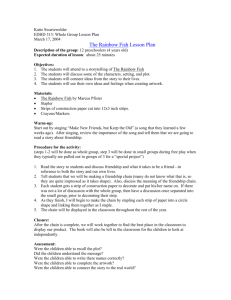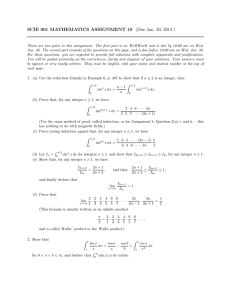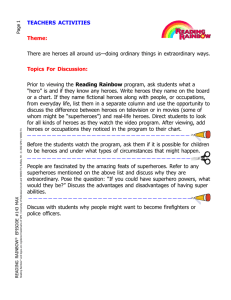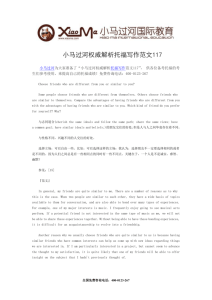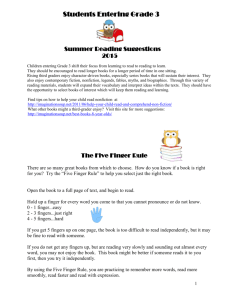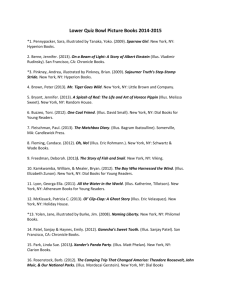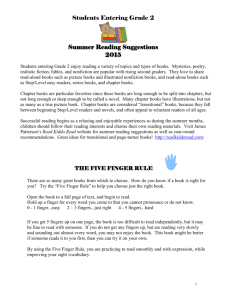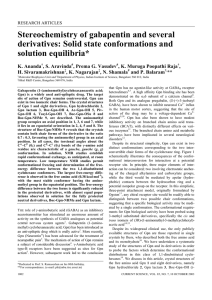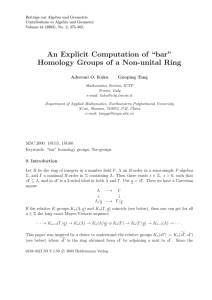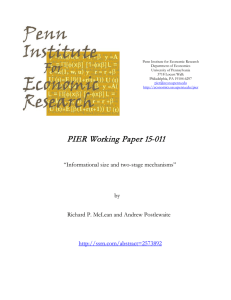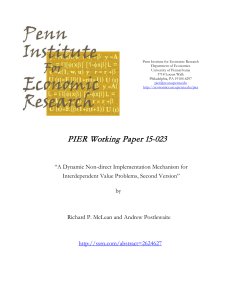TEACHERS ACTIVITIES Theme: Making a friend requires time and
advertisement
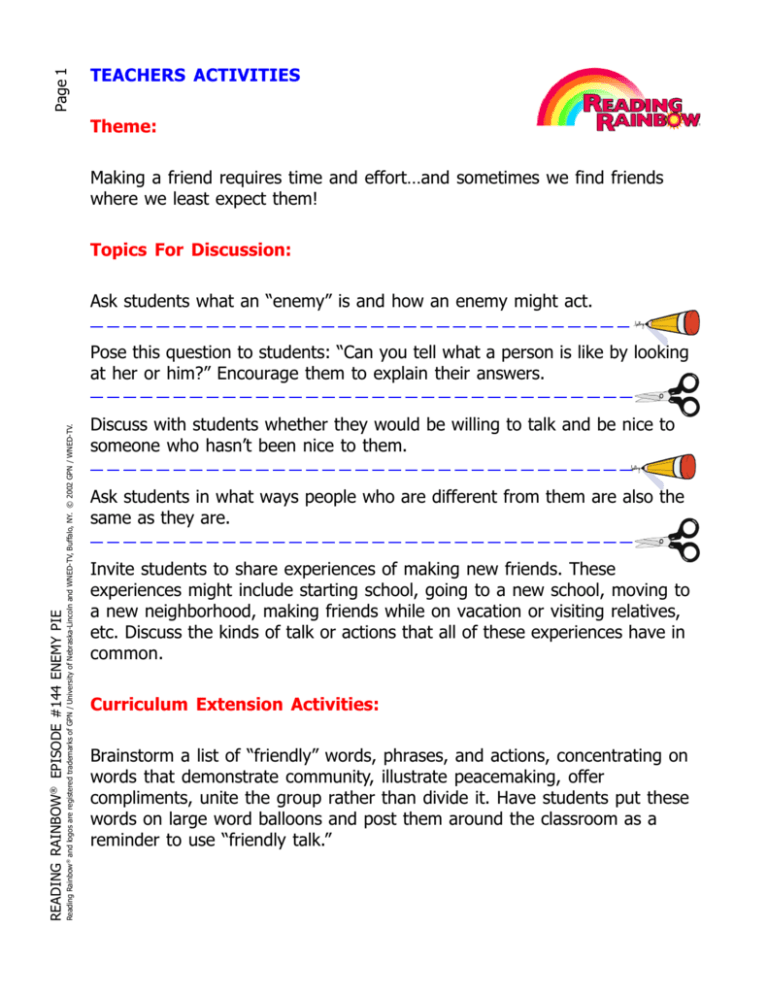
Page 1 TEACHERS ACTIVITIES Theme: Making a friend requires time and effort…and sometimes we find friends where we least expect them! Topics For Discussion: Ask students what an “enemy” is and how an enemy might act. Reading Rainbow® and logos are registered trademarks of GPN / University of Nebraska-Lincoln and WNED-TV, Buffalo, NY. © 2002 GPN / WNED-TV. READING RAINBOW® EPISODE #144 ENEMY PIE Pose this question to students: “Can you tell what a person is like by looking at her or him?” Encourage them to explain their answers. Discuss with students whether they would be willing to talk and be nice to someone who hasn’t been nice to them. Ask students in what ways people who are different from them are also the same as they are. Invite students to share experiences of making new friends. These experiences might include starting school, going to a new school, moving to a new neighborhood, making friends while on vacation or visiting relatives, etc. Discuss the kinds of talk or actions that all of these experiences have in common. Curriculum Extension Activities: Brainstorm a list of “friendly” words, phrases, and actions, concentrating on words that demonstrate community, illustrate peacemaking, offer compliments, unite the group rather than divide it. Have students put these words on large word balloons and post them around the classroom as a reminder to use “friendly talk.” Page 2 Make a class friendship chain. Cut pieces of 9 x 12-inch construction paper into four vertical strips (each 2 ¼ x 12 inches) to use as links in the chain. Invite students to watch for instances in which classmates are being a friend and then write what they saw on a link. Glue or staple the links together in a chain and hang it so that it can begin to encircle the classroom. Make this a year-long activity, adding links, so that the chain “circles the class in friendship.” Have students make “Wanted—Best Friend” posters. Discuss desirable qualities of a best friend and the types of pictures they might draw to illustrate the posters (e.g., friends enjoying activities). Display the posters in the classroom. Reading Rainbow® and logos are registered trademarks of GPN / University of Nebraska-Lincoln and WNED-TV, Buffalo, NY. © 2002 GPN / WNED-TV. READING RAINBOW® EPISODE #144 ENEMY PIE Have students brainstorm a list of “rules” for “How to Be a Friend” and post the list in the classroom. Periodically discuss the list and add new rules as needed. Have students write recipes for “Friendship Stew” or “Friendship Cake” or a similar dish. Gather some children’s cookbooks for them to look at. Discuss measurement quantities, including specific terms (e.g., “cup” and “tablespoon”) and non-specific terms (e.g., “dash” or “sprinkle”). Look at the directions for cooking vocabulary, such as “mix,” “blend,” “simmer,” “bake,” etc. Call their attention to all of the friendship words and actions that are appear on charts, in books, and in activities that students have done in the classroom, and direct them to use these words as their “ingredients.” Make a book, “Recipes for Friendship,” and place it in the school library. Have students, working with their partners from the above activity, draw pictures of their partners. (Use the full vertical length of 12 x 18-inch drawing paper.) Also, have them locate a friendly word or phrase from the list of “friendly” words they generated and write it in a word bubble. Put a long piece of mural paper on the wall and have students create different backgrounds (classroom, playground, lunchroom, swimming pool, soccer field, etc.) in a frieze format (a series of pictures with a border between them). Have them cut out their partner’s picture and the word bubble and place them on one of the backgrounds. Page 3 Reading Rainbow® and logos are registered trademarks of GPN / University of Nebraska-Lincoln and WNED-TV, Buffalo, NY. © 2002 GPN / WNED-TV. READING RAINBOW® EPISODE #144 ENEMY PIE Brainstorm a list of “favorites” about which students can interview each other. These might include such items as favorite color, book, game, TV show, food, song, school activity, animal, etc. Limit the list to five or six items so that the data students collect doesn’t become too cumbersome. Assign each student an interview partner and have the pairs collect the “favorites” information from each other. Then have students create classroom graphs that represents favorite things based on the results of the interviews. Several graphs will be needed, depending on the interview items, such as “Favorite Color” or “Favorite Animal.” Make the graphs as pictographs, using photocopies of the students’ school pictures. Instead of placing their own pictures on the graphs, however, they will place the picture of their interview partner. Display the graphs in the classroom so that students may see what they have in common with their classmates. Use the graphs as an opportunity to discuss how someone’s “likes” may be someone else’s “dislikes” and that we don’t always need to like the same things to be friends. Collect items for a class friendship scrapbook. Show students some examples of scrapbooks so that they can see the types of items people put in scrapbooks, such as pictures, drawings, clippings, artifacts, and other items. Designate a small basket or box for students to put in ideas for the scrapbook or actual items. Each month, delegate a committee comprised of different children to go through the items and make a page for the scrapbook. For each item, they should write a short description telling about the item or why it was chosen for the scrapbook. Keep the materials used for the scrapbook simple. Use cardboard for covers, which can be covered with scraps of contact paper or wallpaper, or the students can decorate it with drawings or pictures cut from magazines. Use recycled paper or grocery sacks cut to fit for the pages. Page 4 Supplemental Books: BEING FRIENDS by Karen Beaumont, illus. by Joy Allen (Dial) DON’T NEED FRIENDS by Carolyn Crimi, illus. by Lynn Munsinger (Doubleday) AND TO THINK THAT WE THOUGHT THAT WE’D NEVER BE FRIENDS by Mary Ann Hoberman, illus. by Kevin Hawkes (Crown) THE VERY BEST (ALMOST) FRIENDS: POEMS OF FRIENDSHIP edited by Paul B. Janeczko, illus. by Christine Davenier (Candlewick Press) Reading Rainbow® and logos are registered trademarks of GPN / University of Nebraska-Lincoln and WNED-TV, Buffalo, NY. © 2002 GPN / WNED-TV. READING RAINBOW® EPISODE #144 ENEMY PIE MATTHEW AND TILLY by Rebecca C. Jones, illus. by Beth Peck (Dutton) LITTLE BLUE AND LITTLE YELLOW by Leo Lionni (Mulberry) WE ALL SING WITH THE SAME VOICE by J. Philip Miller & Sheppard M. Greene, illus. by Paul Meisel (HarperCollins) BEIN’ WITH YOU THIS WAY by W. Nikola-Lisa, illus. by Michael Bryant (Lee & Low) YOU’RE NOT MY BEST FRIEND ANYMORE by Charlotte Pomerantz, ill. by David Soman (Dial) ROSIE AND MICHAEL by Judith Viorst, illus. by Lorna Tomei (Atheneum) YOKO by Rosemary Wells (Hyperion) THE OTHER SIDE by Jacqueline Woodson, illus. by E.B. Lewis (Putnam) Distributed by: P.O. Box 80669 Lincoln, NE 68501-0669 Phone: 800-228-4630 Fax: 800-306-2330 Email: gpn@unl.edu Web site: gpn.unl.edu
